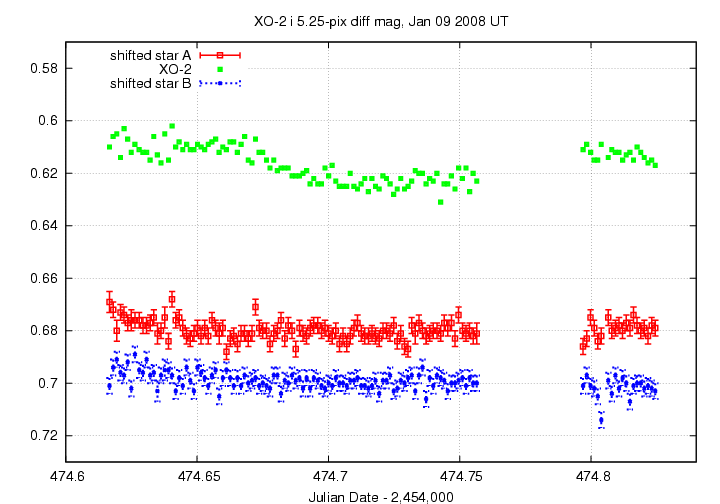
On the night of UT Jan 09, 2008, the SDSS Photometric Telescope ("PT" for short) took a series of exposures of XO-2. We clearly detected the ingress at the time predicted by the ephemeris, but the egress was missed due to clouds.
Notes from the night
This is a chart of the field. XO-2 is the bright star indicated by the crosshairs. The labelled stars will appear in later analysis.

The host star of XO-2 has a magnitude V=11.18 according to XO-2b: Transiting Hot Jupiter in a Metal-rich Common Proper Motion Binary .
Following the procedures outlined by Kent Honeycutt's article on inhomogeneous ensemble photometry, I used all stars available in each image to define a reference frame, and measured each star against this frame. You can find the software package used to do the ensemble photometry online; it's free!
The night was cloudy. The graph below shows the amount by which instrumental magnitudes from each image needed to be shifted to match the ensemble reference. On a clear night, this graph would show a straight horizontal line. Note the gap of about one hour due to clouds.

Below is a graph of the scatter in differential magnitude versus magnitude in the ensemble solution.

XO-2 is the star at differential mag 0.6 with a small excess of scatter over neighboring stars of the same brightness.
Below are the light curves for the target (green symbols) and four comparison stars in the field.

In this closeup, I have shifted the data for two comparison stars to move them closer in magnitude to the target.

The ingress is obvious. I estimate by eye the ingress to start at about 74.67.
An ephemeris grabbed from transitsearch.org predicts for this night
----------------------------------------------------------------------------------------
Begin Transit Window PREDICTED CENTRAL TRANSIT End Transit Window
All Times UT
HJD Year M D H M
2454474.67 2008 1 9 4 6 2454474.73 2008 1 9 5 29 2454474.79 2008 1 9 6 52
----------------------------------------------------------------------------------------
The ephemeris ingress of UT 2008 Jan 09 04:06:00 corresponds to JD 2,454,474.671. This agrees with my eyeball estimate. The ephemeris egress of UT 2008 Jan 09 06:52:00 corresponds to JD 2,454,474.786. This falls within the gap in the measurements.
You can grab the measurements for your own analysis. Below is a table with three flavors of time, plus the differential magnitude of the target and an estimate of the uncertainty in each measurement. I show the first few lines of the file to give you an idea of its format.
# Measurements of XO-2 made with APO PT, Jan 9, 2008 UT. # Each exposure 35 seconds long in SDSS i-band; # Tabulated times are midexposure (FITS header time - half exposure length) # and accurate only to +/- 1 second (??). # 'mag' is a differential magnitude based on ensemble photometry # using a circular aperture of radius 5.25 arcseconds. # # UT day JD-2,450,000 HJD-2,450,000 mag uncert Jan09.61665 4474.61665 4474.62164 0.610 0.004 Jan09.61805 4474.61805 4474.62304 0.606 0.003 Jan09.61941 4474.61941 4474.62440 0.605 0.003
Last modified 02/23/2008 by MWR.